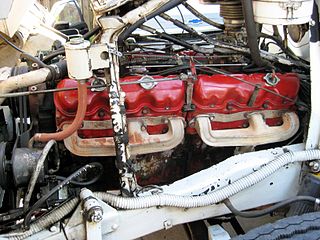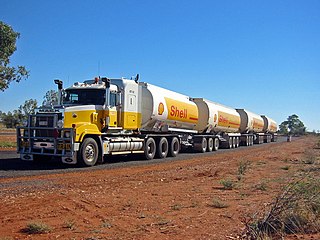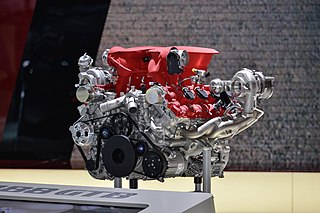The Detroit Diesel Series 50 is an inline four-cylinder diesel engine, that was introduced in 1993 by Detroit Diesel. The Series 50 was developed from the existing block of its sister engine, the Series 60, which itself was initially designed by Detroit Diesel. The cylinder heads were cast by John Deere at one time.
Detroit Diesel Corporation(DDC) is an American diesel engine manufacturer headquartered in Detroit, Michigan. It is a subsidiary of Daimler Truck North America, which is itself a wholly owned subsidiary of the multinational Daimler Truck AG. The company manufactures heavy-duty engines and chassis components for the on-highway and vocational commercial truck markets. Detroit Diesel has built more than 5 million engines since 1938, more than 1 million of which are still in operation worldwide. Detroit Diesel's product line includes engines, axles, transmissions, and a Virtual Technician service.

The GMC V6 is a family of 60-degree V6 engines produced by the GMC division of General Motors from 1959 through 1974. It was developed into both gasoline and diesel versions, and produced in V8 and V12 derivatives. Examples of this engine family were found in pickup trucks, Suburbans, heavier trucks, and motor coaches.

The Cummins B Series is a family of diesel engines produced by American manufacturer Cummins. In production since 1984, the B series engine family is intended for multiple applications on and off-highway, light-duty, and medium-duty. In the automotive industry, it is best known for its use in school buses, public service buses in the United Kingdom, and Dodge/Ram pickup trucks.
The Cummins L-series engine is a straight-six diesel engine designed and produced by Cummins. It displaces 8.9 litres (543.1 cu in), and began production in 1982 as the L10 at the Jamestown Engine Plant in Jamestown, New York. After lengthening its stroke from 136 to 147 mm, its displacement was enlarged to 10.8 litres and the engine renamed ISM 11, later M11.

Alpina Burkard Bovensiepen GmbH & Co. KG is an automobile manufacturing company based in Buchloe, in the Ostallgäu district of Bavaria, Germany that develops and sells high-performance versions of BMW cars. Alpina works closely with BMW and their processes are integrated into BMW's production lines, and is recognized by the German Ministry of Transport as an automobile manufacturer, in contrast to other performance specialists, which are aftermarket tuners. The Alpina B7 is produced at the same assembly line in Dingolfing, Germany, as BMW's own 7 Series. The B7's twin-turbo 4.4-litre V8 is assembled by hand at Alpina's facility in Buchloe, Germany, before being shipped to BMW for installation, and the assembled vehicle is then sent back to Alpina for finishing touches.

The General Motors–Detroit Diesel V8 engine is a series of diesel V8 engines first introduced by General Motors for their C/K pickup trucks in 1982. Developed in collaboration with GM subsidiary Detroit Diesel, the engine family was produced by GM through 2002, when it was replaced by the new Duramax line. AM General's subsidiary General Engine Products (GEP) still produces a military variant of this engine for the HMMWV.

The Detroit Diesel Series 71 is a two-stroke diesel engine series, available in both inline and V configurations, manufactured by Detroit Diesel. The number 71 refers to the nominal displacement per cylinder in cubic inches, a rounding off of 70.93 cu in (1.2 L).

The Mack Titan is a heavy-duty truck produced by Mack Trucks. Two variants are produced: one for the Australian market, introduced in 1995 aimed at heavy road train operators, and a 2008 version introduced in North America. The Titan can haul loads up to 200 tonnes GCM and comes with many heavy-duty options that are not usually found on highway trucks.
The Detroit Diesel 149 is a series of two-stroke diesel engines manufactured by Detroit Diesel which were first announced in early 1966. After Detroit Diesel was spun off in 1988 and later acquired by MTU, production of Series 149 engines was discontinued around 2000.
The Nissan ZD30 engine family is a 3.0-litre inline-four cylinder diesel engine with a bore and stroke of 96 mm × 102 mm, that replaced the Nissan QD, BD and TD engines. At Renault it also replaced the Sofim 8140 engine and is the only truck diesel engine which remained with Nissan Motors when they sold Nissan Diesel to Volvo trucks in 2007.

The Land Rover Range Rover (LP), generally shortened to Range Rover, is the second-generation Range Rover model from British car maker Land Rover. It was launched on 28 September 1994, 24 years after the introduction of the Range Rover Classic. It included an updated version of the Rover V8 engine, with the option of a 2.5-litre BMW six-cylinder turbo-diesel. The new model offered more equipment and premium trims, positioning the vehicle above the Land Rover Discovery to face the increased competition in the SUV marketplace.
The Zytek ZRS03 engine is a 3.4-litre normally-aspirated V8 racing engine, developed and produced by Zytek for Formula V8 3.5, a series 1st-tier division for World Series by Renault. The ZRS03's rev-limit to 9,500 rpm and produces its power output about 530 hp (395 kW) and torque about 447 N⋅m (330 ft⋅lbf). The ZRS03 was introduced on 24 August 2011. The ZRS03 engine running on Elf LMS 102 RON fuel.

The Ferrari F154 is a family of modular twin-turbocharged, direct injected V8 petrol engines designed and produced by Ferrari since 2013. It is a replacement for the naturally aspirated Ferrari/Maserati F136 V8 family on both Maserati and Ferrari cars. They are the first turbocharged Ferrari road engines since the 1987 2.9-litre F120A V8 of the Ferrari F40.

The Volkswagen-Audi V8 engine family is a series of mechanically similar, gasoline-powered and diesel-powered, V-8, internal combustion piston engines, developed and produced by the Volkswagen Group, in partnership with Audi, since 1988. They have been used in various Volkswagen Group models, and by numerous Volkswagen-owned companies. The first spark-ignition gasoline V-8 engine configuration was used in the 1988 Audi V8 model; and the first compression-ignition diesel V8 engine configuration was used in the 1999 Audi A8 3.3 TDI Quattro. The V8 gasoline and diesel engines have been used in most Audi, Volkswagen, Porsche, Bentley, and Lamborghini models ever since. The larger-displacement diesel V8 engine configuration has also been used in various Scania commercial vehicles; such as in trucks, buses, and marine (boat) applications.

The Detroit Diesel Series 53 is a two-stroke diesel engine series, available in both inline and V configurations, manufactured by Detroit Diesel as a more compact alternative to the older Series 71 for medium and heavy duty trucks. The number 53 refers to the nominal swept displacement per cylinder in cubic inches.










